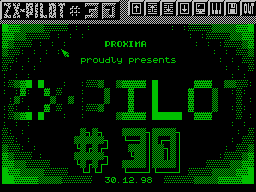|
ZX Pilot #30
19 декабря 1998 |
|
HARD and SOFT - Connect the monitor to the CGS Spectrum.

H A R D A N D S O F T
(C) VEL
Hi! Today we talk about iron, but
it is not difficult to finalize Pentagon'a.
A little background. It all started long ago, when I parted
with poor mono sound from the speaker of my TV. Taurus has
collected for me and I cool'ny usilok connected to it at least
cool'nye column.
That's when me and began to pester friends and acquaintances
by saying that I have sound some do not like that.
Mongol said that with the help of Syrus'a
made some sort of revision is not difficult, from
What sound was just class.
When I finally tired of "attacks" Friends, I went to visit
with Syrus'u because it was he who first made these things
better.
All well and found out for writing
paper, I went home. On the day of
my great happiness to me looked
Shotgun, and I persuaded him to make me
this wonder-completion (do not misunderstand me - well, I do
not like to climb into your PC :-)
All operations on my Pentagon'om ended pretty dystro and as
it turned later, successfully. After I turned
computer, Shotgun finally found their Mouzon, and I heard a new
music in games and demos.
After all this, and Sam made this
completion and was very pleased.
So now four people have improved the sound of their favorite
Pentagon'ov: Syrus / EI, Mongol / DC, Vel / PXM, Sam / PXM. A
because many Pentagon'ov in Russia and CIS!
Okay, enough of the lyrics and go directly to the
description of your revision com.
You only need that connect the 22-th
leg AY-3-8910 (or 15 th leg AY-3-8912)
wire with the third leg m / s 155IE7 before
This unsolder it (wire), if it was connected to the other leg.
Hopefully, the following is not clever design will help you
figure it out yourself.
AY-3-8910
22-th leg
3rd leg
155IE7
° ° ° ° °
(C) AV Apollo, Arzamas, 1998
Connection CGA-Monitor
Recently, when connected to the ZS-256-T +
Color IBM'ovskogo CGA-Monitor had
face several problems: since the CGA
Monitors are designed for TTL signals levels
positive polarity signals lowercase
and frame synchronization is required to invert, but the main
drawback - because of individual signal Intensity (brightness)
there is a bright-white (whitish) color,
which makes the graphics are terrible.
Below is my shemka, providing easy connection CGA-Monitor,
and This black color - always black, ie
provided to all 15 (not 16!) Spectrum colors.
1
CSI-3 'CSI
12D42 2 o 9 CGA
D1.1
4
-FID '6 IPS
13D42 5 o 8 CGA
D1.2
R VD1 R1 2K R
7D43> 3 CGA
G VD2 G
4D43> 4 CGA
B VD3 9 B
12D43> 'August 5 CGA
I 10 o
9D43 D1.3
VD1-3 KD520 1912
'11 I
D1 K555LA3 13 o 6 CGA
D1.4
RGB signals to the monitor are taken directly from the chip
D43 (KP11).
Scheme is sufficiently critical to par
resistor R1.
Built-CGA (9-pin):
1 Earth Shield
2 Ground Land
3 Red Red
4 Green Green
5 Blue Blue
6 Intensity Brightness
7 Nc Reserve
8 H. Sync Str.Sinhr.
9 V. Sync Kadr.Sinhr.
Similarly, you can connect a CGA-Monitor
to any Spectrum.
For the Pentagon-128 signals must be taken with
the following chips:
Brightness - 9 foot D47
str.sinhr - 1 foot D6
kadr.sinhr - 2 foot D6
Red R - 3 foot D72
Green G - 6 foot D72
blue B - 8 foot D72
By the way, you can use and EGA monitors. They are designed
to operate in two modes - CGA and EGA. This is sometimes
visible indication of MODE 1 and MODE 2 on the body monitor.
EGA - Monitor analyzes the polarity of horizontal sync pulses
arriving at its input. If the polarity is is positive, then the
relay switches the unit line scan at a frequency of about 16 kHz
(MODE1-CGA). If the vertical sync
have a negative polarity, the monitor
switches to the frequency of EGA - about 22 kHz
(MODE 2).
Built-EGA (9-pin):
1 Ground
2 Dop.Krasny
3 Red
4 Green
5 Blue
6 Dop.Zeleny
7 Dop.Siny
8 Str.Sinhr.
9 Kadr.Sinhr.
Other articles:
Similar articles:
В этот день... 30 December